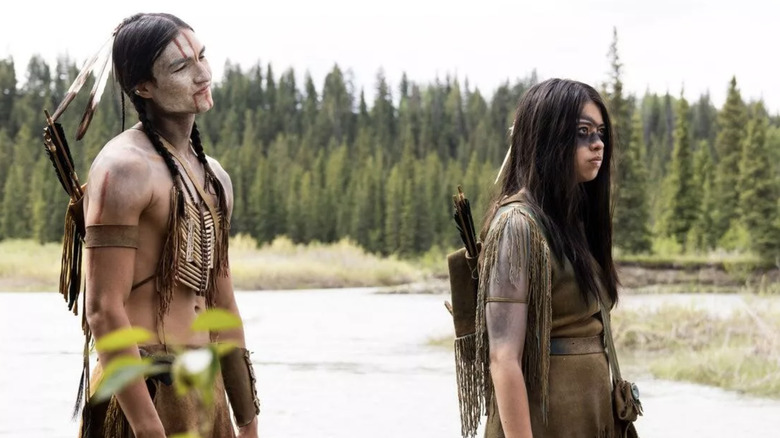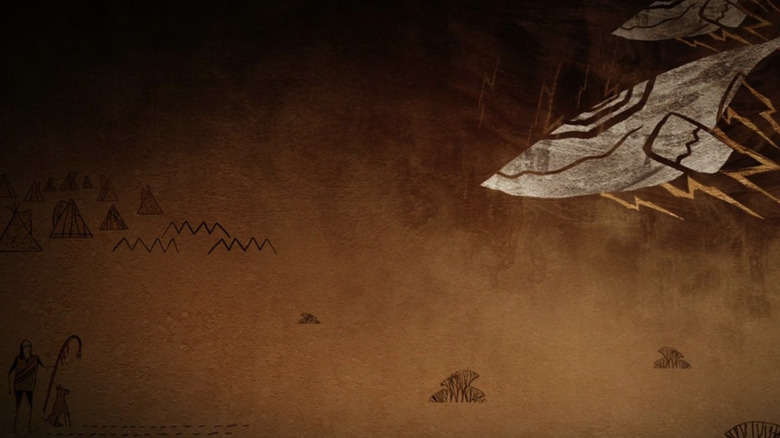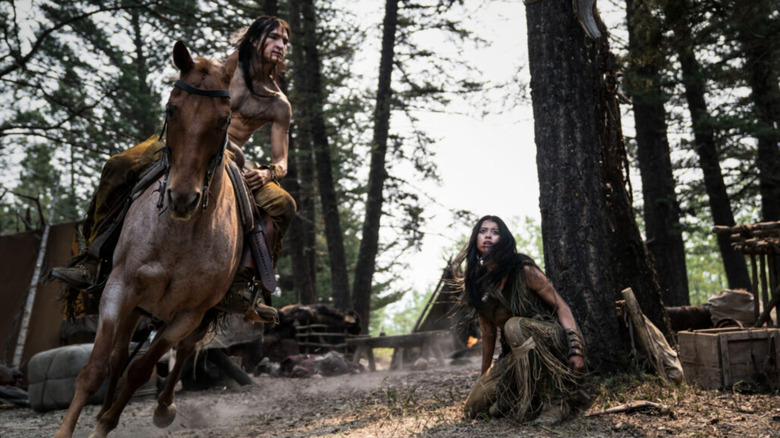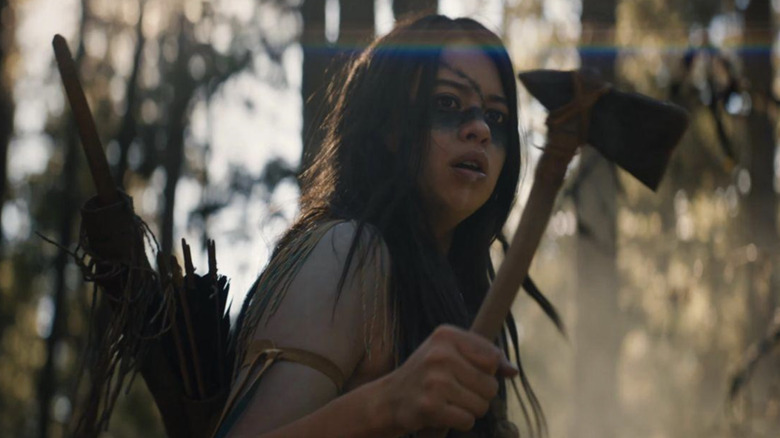'Authenticity' Was The Name Of The Game For Prey's Indigenous Representation
There is a period-piece level of realism that adorns the blood-soaked plot of "Prey," director Dan Trachtenberg's retelling of a familiar story about a certain solitary alien landing on Earth to hunt the populace. After all, one of the big reasons it distinguishes itself from previous "Predator" films is its setting. "Prey" abandons the increasingly dull modern and future set timelines of the sequels in favor of the Great Plains circa 1719. There the film follows the journey of Naru, a young Comanche woman trained as a healer with aspirations (and enough great skill) to be a hunter, as she's forced to protect her tribe from an onslaught of dangers.
Countless times throughout my first watch of "Prey," I kept thinking how much it reminded me of "The Revenant" — from its intimately visceral action sequences that put you at the center of the commotion to its brutal presentation of life on the frontier. Another exceptionally important aspect of maintaining not just the realism but the authenticity of "Prey" included the representation of Indigenous people and culture.
To this end, the film has been greatly lauded, with the most talked about example being the Comanche dub (which you should watch first) that was made available alongside the English version of the film. But that's just one of the ways "Prey" was created to be both respectful and accurate. Something that was accomplished thanks to producer Jhane Myers and the many Indigenous/Comanche experts she consulted.
Comanche Nation member and producer Jhane Myers was a driving force
Myers, who had worked previously on "Apocalypto" and "Wind River," is no stranger to working as either a consultant or in outreach with Indigenous communities for films. She's also an enrolled member of the Comanche Nation and part Blackfeet, something she shared with many of the people working behind the scenes to reconstruct the life of the Indigenous tribes that lived on the Great Plains in the 1700s.
Speaking with Gazette, Myers revealed as a producer on "Prey" she was able to surround herself with people ready and willing to fill in the gaps in Comanche history and culture that was period-specific. Having that presence behind the scenes proved invaluable in ensuring the film would not make many of the same mistakes as previous Hollywood productions about Indigenous people. "If I had a question, I could text somebody and get an answer right away," she said. "People were all willing to help because they love the Predator."
Myers comments reveal it's not enough to just have Native actors playing roles in film and television — there also needs to be plenty of representation in the crew, in the role of producer, and even director. "I think this film, when it comes to authenticity and representation, sets the bar — and it shifts a little bit against the paradigm that Hollywood has created for Native people," Myers told National Geographic. On "Prey" there were Native people working in every department, a feat she likens to Sterlin Harjo and Taika Waititi's show "Reservation Dogs."
Finding historical sources to base renderings of the Comanche on was a challenge
One of the reasons Myers was appreciative of the amount of help she received behind the scenes was owed to the lack of historical documents about the Comanche. "Very little is written about that time," she told National Geographic. "If you go and research artefacts, hardly anything exists from the 1700s." But that's mainly because Comanche history and culture is passed down through an oral tradition.
Luckily, Myers had access to people with that knowledge and she compiled binders full of the information to consult throughout production. Together, they nailed important nuances like the hairstyles or fighting strategies of the Comanche, as well as rendering accurate color palettes for their clothes based on plant pigments that would've been native to the Great Plains. But Myers' presence also helped prevent any egregious blunders — like advocating against the absence of horses in one version of the script. "We're a horse culture," she told Radio Times, so the possibility of showing Naru's tribe not riding or even owning any was unacceptable.
So they wrote in a horse into the movie as belonging to Taabe and also added a shot of some in the camp. Even the hide-art drawings that are shown at the end of the film during the credits — which depict an allusion to a much anticipated sequel — were based off Comanche tradition. This just goes to show that when it comes to accurate representation no detail is too small or inconspicuous to get wrong.
Prey cast on the importance of authenticity
Possibly the group of people most grateful for the diligent work done by Myers and her consultants is the cast, which included a large number of Indigenous and First Nations actors. There's Dakota Beavers, who plays Taabe, the stalwart older brother of Naru (Amber Midthunder) whom she looks up to. His character has actually been confirmed to share a link with another Native person in the franchise: Billy Sole, the tracker played by Sonny Landham (himself part Cherokee) in the original "Predator." Actor Bennett Taylor was the one to reveal that the script for "Prey" affirms Billy is actually a reincarnation of Taabe — right down to their heroic last stands against the alien.
For her part, Midthunder told National Geographic there was a need to show the "dark parts of history" — like the disturbing encounter she has with a buffalo herd slaughtered by French trappers and then the innate sexism she experiences from other male Comanche hunters. But "Prey" was also an opportunity to "normalize Native society," to give a vision of Indigenous life pre-colonization that's either never spoken of or often outright distorted.
"To show the way that things were thriving, when communities were in charge of their own societies," she said. "'Oh look, they were innovative, and intelligent...' Just day to day things. The hygiene even. People brushing their teeth." That's right — that toothbrush Naru uses in the film is no accidental anachronism. Myers found out what kind of tools the Comanche were using to keep their teeth clean in the 1700s and they inserted it into the movie. And Midthunder is right, those little details are important in eliminating harmful stereotypes for Indigenous people.



